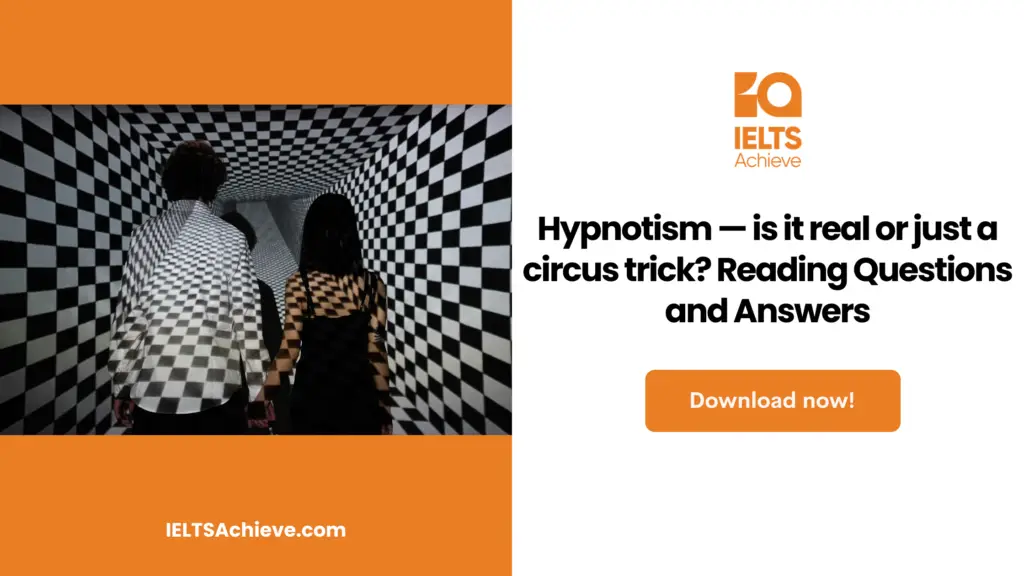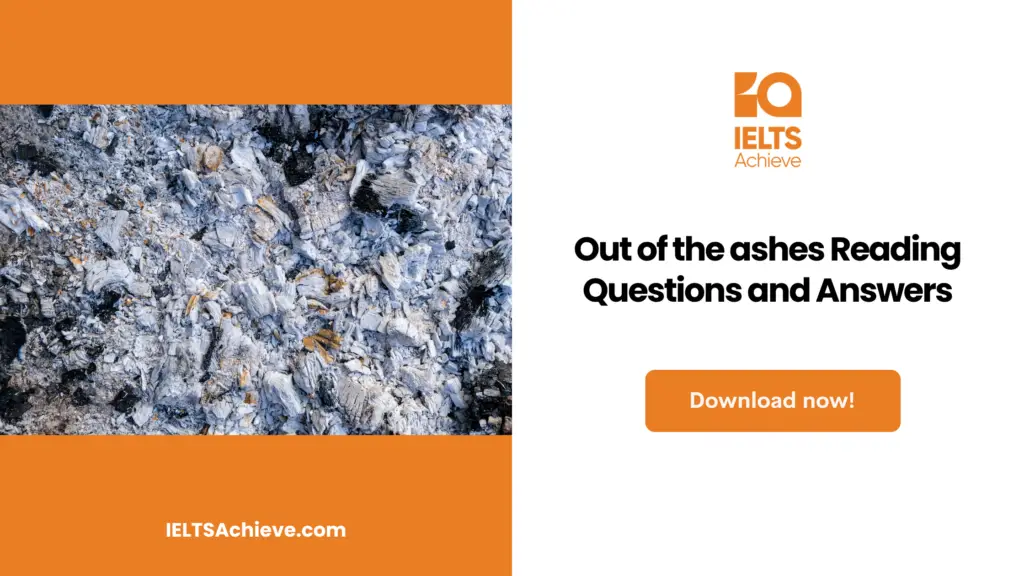The Blog post contains the following IELTS Reading Questions:
- IELTS Reading Matching Headings
- IELTS Reading True/False/Not Given
- IELTS Reading Multiple Choice Questions
Stay informed and prepared for success – Explore our comprehensive Reading Test Info page to get valuable insights, exam format details, and expert tips for mastering the IELTS Reading section.
IELTS Reading Passage – Hypnotism — is it real or just a circus trick?

Hypnotism — is it real or just a circus trick?
A Hypnosis has been shown through a number of rigorously controlled studies to reduce pain, control blood pressure, and even make warts go away. But because very few studies have attempted to define the actual processes involved, most scientists are sceptical of its power and uses. That scepticism has driven David Spiegel, a professor of psychiatry at Stanford University School of Medicine, USA, and other researchers to take a hard look at what happens in the brain during hypnosis.
Among researchers there are two schools of thought. One claims that hypnosis fundamentally alters subjects’ state of mind: they enter a trance, which produces changes in brain activity. The other believes that hypnosis is simply a matter of suggestibility and relaxation. Spiegel belongs to the first school and over the years has had a debate with two scientists on the other side, Irving Kirsch, a University of Connecticut psychologist, and Stephen Kosslyn, a Harvard professor.
B Kirsch often uses hypnosis in his practice and doesn’t deny that it can be effective. ‘With hypnosis you do put people in altered states,’ he says. ‘But you don’t need a trance to do it.’ To illustrate the point, Kirsch demonstrates how a subject holding a small object on a chain can make it swing in any direction by mere suggestion, the chain responding to minute movements in the tiny muscles of the fingers. ‘You don’t have to enter a trance for your subconscious and your body to act upon a suggestion,’ Kirsch says. ‘The reaction is the result of your focusing on moving the chain in a particular direction.’
Spiegel disagrees. One of his best known studies found that when subjects were hypnotised and given suggestions their brain wave patterns changed, indicating that they had entered a trance. In one of his studies, people under hypnosis were told their forearms were numb, then given light electrical shocks to the wrists. They didn’t flinch or respond in any way, and their brain waves resembled those of people who experienced a much weaker shock. To Kirsch this still wasn’t enough to prove the power of trance, but Stephen Kosslyn was willing to be convinced. Many external factors could have been responsible for the shift in the subjects’ state of mind, but Kosslyn wondered, ‘Is there really something going on in the brain?’
C To find out, Spiegel and Kosslyn decided to collaborate on a study focusing on a part of the brain that is well understood: the circuit which has been found to process the perception of colour. Spiegel and Kosslyn wanted to see if subjects could set off the circuit by visualising colour while under hypnosis. They selected eight people for the experiment conducted at Massachusetts General Hospital. The subjects were put in a scanner and shown a slide with coloured rectangles while their brain activity was mapped. Then they were shown a black and white slide and told to imagine its having colour. Both tasks were then repeated under hypnosis.
The results were striking. When the subjects truly saw the coloured rectangles, the circuit lit up on both sides of the brain; when they only had to imagine the colour, the circuit lit up only in the right hemisphere. Under hypnosis, however, both sides of the brain became active, just as in regular sight; imagination seemed to take on the quality of a hallucination.
After the experiment, Kosslyn was forced to admit, ‘I’m absolutely convinced now that hypnosis can boost what mental imagery does.’ But Kirsch remained sceptical, saying, ‘The experiments demonstrate that people are experiencing the effects of hypnotic suggestion but don’t prove that they are entering a trance.’ He also argued that subjects were told to see the card in colour when they were hypnotised but only to imagine it in colour when they weren’t. ‘Being told to pretend you’re having an experience is different from the suggestion to have the experience.’
D Spiegel, however, is a clinician first and a scientist second. He believes the most important thing is that doctors recognise the power of hypnosis and start to use it. Working with Elvira Lang, a radiologist at a Harvard Medical Centre, he is testing the use of hypnosis in the operating room just as he and Kosslyn did in the scanner. Spiegel and Lang took 241 patients scheduled for surgery and divided them into three groups. One group received standard care, another standard care with a sympathetic care provider and the third received standard care, a sympathetic care provider and hypnosis. Every 15 minutes the patients were asked to rate their pain and anxiety levels. They were also hooked up to painkilling medication which they could administer to themselves.
On average, Spiegel and Lang found the hypnotised subjects used less medication, experienced less pain and felt far less anxiety than the other two groups. Original results published in The Lancet have been further supported by ongoing studies conducted by Lang.
E Spiegel’s investigations into the nature of hypnosis and its effects on the brain continue. However, if hypnosis is ever to work its way into mainstream medicine and everyday use, physicians will need to know there is solid science behind what sounds like mysticism. Only then will their reluctance to using such things as mind over matter be overcome. ‘I agree that the medical use of hypnotism should be based on data rather than belief,’ says Spiegel, ‘but in the end it doesn’t really matter why it works, as long as it helps our patients.’
Unlock your full potential in the IELTS Reading section – Visit our IELTS Reading Practice Question Answer page now!
Recommended Questions:
Renewable Energy IELTS Reading Question with Answer
Questions 27-31
Reading Passage 3 has five sections, A-E. Choose the correct heading for each section from the list of headings below.Write the correct number, i-vii, in boxes 27-31 on your answer sheet.
List of Headings
i An experiment using people who are receiving medical treatment
ii The experiment that convinced all the researchers
iii Medical benefits of hypnosis make scientific proof less important
iv Lack of data leads to opposing views of hypnotism
v The effects of hypnosis on parts of the brain involved in vision
vi Inducing pain through the use of hypnotism
vii Experiments used to support conflicting views
27 Paragraph A
28 Paragraph B
29 Paragraph C
30 Paragraph D
31 Paragraph E
Ready to conquer Matching Headings questions? Click here to learn essential tips and techniques for matching headings accurately to paragraphs or sections in the IELTS Reading section.
Questions 32-36
Choose the correct letter A, B, C or D.
32 Kirsch uses a small object on a chain to demonstrate that
A inducing a trance is a simple process
B responding to a suggestion does not require a trance
C muscles respond as a result of a trance
D it is difficult to identify a trance
33 Spiegel disagrees with Kirsch because the subjects in Spiegel’s experiment
A believed what they were told
B showed changes in brain activity
C responded as expected to shocks
D had similar reactions to control subjects
34 Kosslyn’s response to Spiegel’s electric shock experiment was to
A challenge the results because of external factors
B work with Kirsch to disprove Spiegel’s results
C reverse his previous position on trance
D accept that Spiegel’s ideas might be correct
35 Spiegel and Kosslyn’s experiment was designed to show that hypnosis
A affects the electrical responses of the brain
B could make colour appear as black and white
C has an effect on how shapes are perceived
D can enhance the subject’s imagination
36 Kirsch thought Spiegel and Kosslyn’s results
A were worthy of further investigation
B had nothing to do with hypnotic suggestion
C showed that the possibility of trance existed
D were affected by the words used in the instructions
Ready to improve your performance in Multiple Choice Questions (MCQs)? Click here to access our comprehensive guide on how to tackle MCQs effectively in the IELTS Reading section.
Questions 37-40
Do the following statements agree with the information given in Reading Passage 3? In boxes 37-40 on your answer sheet, write
TRUE if the statement agrees with the information
FALSE if the statement contradicts the information
NOT GIVEN if there is no information on this
37 Spiegel is more interested in scientific research than medical practice.
38 Patients in the third group in Spiegel and Lang’s experiment were easily hypnotised.
39 In Spiegel and Lang’s experiment, a smaller amount of painkiller was needed by the hypnotised patients than by the other two groups.
40 Spiegel feels that doctors should use hypnotism only when it is fully understood.
Enhance your skills in identifying information as True, False, or Not Given. Click here to discover expert strategies and techniques for mastering this question type in the IELTS Reading section.
Unlock your full potential in the IELTS Reading section – Visit our IELTS Reading Practice Question Answer page now!
Recommended Questions:
Renewable Energy IELTS Reading Question with Answer

We hope you found this post useful in helping you to study for the IELTS Test. If you have any questions please let us know in the comments below or on the Facebook page.
The best way to keep up to date with posts like this is to like us on Facebook, then follow us on Instagram and Pinterest. If you need help preparing for the IELTS Test, join the IELTS Achieve Academy and see how we can assist you to achieve your desired band score. We offer an essay correction service, mock exams and online courses.

